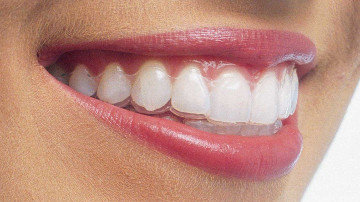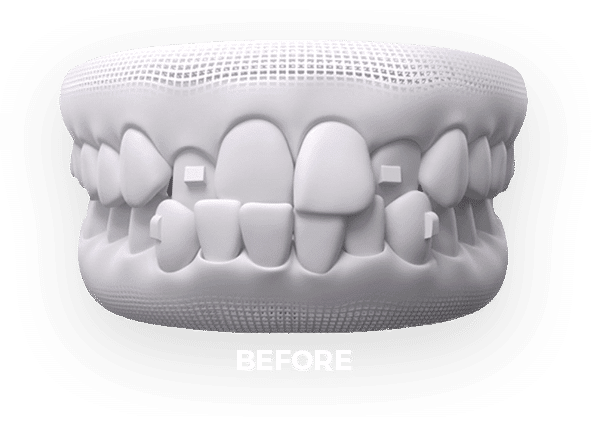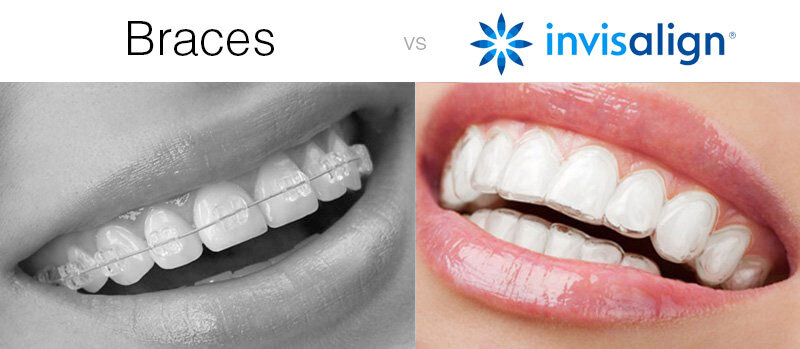How Invisalign Works: Your Overview to Clear Aligners and Their Effectiveness
Wiki Article
Invisalign vs. Conventional Braces: Which Option Is Right for You?
When taking into consideration orthodontic therapy, the option in between Invisalign and traditional dental braces provides numerous vital elements that merit cautious analysis. Invisalign uses a discreet option with detachable aligners, while traditional braces provide a much more visible yet effective solution for severe misalignment.Review of Therapy Alternatives

On the other hand, standard braces contain steel braces and cables that are adhered to the teeth. This technique uses continual pressure in time to accomplish positioning. While effective for complex orthodontic problems, typical dental braces need regular visits for modifications and can position difficulties in maintaining oral health due to the problem of cleaning about wires and braces.
Both options have their qualities, and the option usually depends upon specific dental problems, lifestyle choices, and individual conformity. Eventually, getting in touch with an orthodontic professional is important for establishing the most suitable treatment strategy tailored to private demands. Recognizing the nuances of each alternative can significantly affect the total success of orthodontic treatment.
Aesthetic Considerations
A considerable variable affecting the selection in between Invisalign and standard braces is the aesthetic allure each therapy provides. Invisalign aligners are crafted from clear plastic, making them basically undetectable when put on.In contrast, traditional braces contain metal braces and cords, which can be much more obvious. While advancements in orthodontic modern technology have actually led to the advancement of smaller brackets and colored elastics, conventional braces still keep an even more noticeable account. For some people, the presence of dental braces may prevent them from seeking necessary treatment.
Inevitably, the selection in between Invisalign and traditional dental braces may rest on personal preferences pertaining to aesthetic appeals. People that focus on discretion often favor Invisalign, while those that are much less worried about exposure may select typical dental braces. Recognizing the visual effects of each option is crucial for making an educated decision that lines up with one's way of living and preferences.
Comfort and Convenience

In regards to convenience, Invisalign aligners are detachable, enabling individuals to appreciate their favored foods without constraint and maintain optimum dental health. Brushing and flossing are streamlined, as the aligners can be gotten throughout these regimens, whereas typical braces call for careful maneuvering around braces and wires.
In contrast, standard dental braces require routine changes, making them much less practical for those with active routines. Generally, the comfort and convenience of Invisalign make it an appealing option for many individuals looking for orthodontic treatment.
Treatment Duration and Effectiveness
While both Invisalign and standard braces are reliable in dealing with dental misalignments, the period of therapy can differ substantially in between the 2 alternatives. Generally, Invisalign treatment can take anywhere from 12 to 18 months, depending upon the complexity of the instance. The clear aligners work by gradually moving teeth right into their desired positions, and routine follow-ups with an orthodontist aid ensure progress continues to be on the right track.
On the other hand, conventional dental braces typically require a longer commitment, generally ranging from 18 months to 3 years. This is due to their set nature and the use of informative post cables and braces, which can be much more effective for complicated situations and serious imbalances (Invisalign). The treatment performance of traditional braces is well-documented, as they permit accurate modifications and higher control over tooth movement
Ultimately, the selection between Invisalign and traditional dental braces might depend upon both the expected treatment duration and the details oral concerns available. Consulting with an orthodontist is important, as they can supply tailored referrals based on individual demands, making certain the chosen technique aligns with wanted outcomes and timeframes.
Price Contrast and Insurance Options
Price plays a substantial duty in the decision-making procedure for people taking into consideration orthodontic treatment, whether selecting Invisalign or traditional dental braces. Generally, the expense of Invisalign arrays from $3,000 to $8,000, while standard braces usually set you back in between $2,000 and $6,000. Variables influencing these expenses consist of the intricacy of the case, the duration of treatment, and geographical location.Insurance insurance coverage can significantly affect out-of-pocket expenditures. Numerous dental insurance coverage plans give partial insurance coverage for orthodontic therapies, yet the specifics can differ commonly. It is critical for clients to evaluate their insurance coverage to establish the level of coverage for either choice. Normally, conventional dental braces might be extra regularly covered by insurance plans compared to Invisalign, which some insurance providers categorize as an aesthetic procedure.
Furthermore, a number of orthodontic methods supply versatile settlement strategies, making both therapy options a lot more easily accessible. Clients should make inquiries about prospective financing choices and discounts for upfront repayments. Evaluating the overall cost, including insurance advantages and repayment plans, is vital for making a notified decision that straightens with both aesthetic preferences and spending plan considerations.

Conclusion
In recap, the selection between Invisalign and conventional dental braces hinges on several factors, consisting of aesthetic preferences, comfort, treatment duration, and price. Invisalign supplies a discreet, detachable alternative that facilitates oral health and nutritional flexibility, site while standard braces may be much more suitable for complex dental concerns and usually come at a reduced cost factor. Inevitably, examination with an orthodontist is vital to analyze individual situations and determine one of the most suitable therapy alternative for attaining optimum oral positioning.click this link When considering orthodontic treatment, the selection between Invisalign and standard dental braces offers numerous essential factors that warrant mindful examination.Comparing Invisalign and conventional braces reveals distinct treatment alternatives for orthodontic correction.While both Invisalign and traditional braces are efficient in dealing with oral imbalances, the period of treatment can vary considerably in between the two alternatives.Cost plays a significant duty in the decision-making procedure for people thinking about orthodontic therapy, whether opting for Invisalign or conventional braces.In recap, the choice between Invisalign and traditional braces pivots on numerous elements, consisting of visual choices, convenience, therapy period, and price.
Report this wiki page